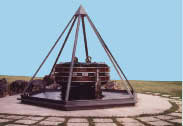The International Linear Collider (ILC) will be an electron-positron machine,
designed to run at a center of mass energy of 500 GeV extendible up to 1 TeV.
The main aim of the experiment is the proof of the electroweak symmetry breaking
process, through the Higgs mechanism. But the high energy and the achievable
precision of the initial states definition in the collision extends its potential to the
investigation of new physics, beyond the Standard Model. One of the four possible
detector concepts for ILC (the Large Detector Concept -LDC) points to a precise
measurements of such a complex and unpredictable physics scenario. It consists of a
compact tracker, electromagnetic and hadron calorimeter, inserted into a magnetic
coil. A muon chamber surrounds it. The hadron calorimeter, developed by the
Calice Collaboration, in the framework of LDC, is presented in this seminar, with
particular emphasis on its impact on the physics measurements at ILC.
The main role of the hadron calorimeter is to separate with high resolution the
final multi jet states, which are a typical feature of most of the key physics processes
studied at ILC. The missing energy signatures of many new physics channels impose
a very good energy resolution and a good hermeticity. The proposed solution to this
problem is a high granularity analog calorimeter, with scintillator tiles as absorber
and steel as radiator. The sensitive layer is composed of an array of 3 × 3 × 0:5 cm 3
scintillator tile and the total thickness of the layer is . 3 cm, resulting in a high
spatial resolution, both transversely and laterally. Each tile is read out by a Silicon
Photomultiplier. Its small size (1 × 1 mm 2 ), high gain (0:5 - 1 × 10 6 ), and relatively
low bias voltage (30V-60V) makes this novel photodetector ideal for the design of
this compact imaging calorimeter: the SiPM can be installed directly in the tile.
A 1 m 3 prototype of this calorimeter was built at DESY and a test beam program
is currently running in CERN. The recent results of the response of the hadron
calorimeter to pions, muons and electrons will be shown. In addition, the continuous
evolution of the design of the Silicon photomultiplier and its impact in the future
calorimeter design, in the framework of the ongoing R&D, will be discussed.
